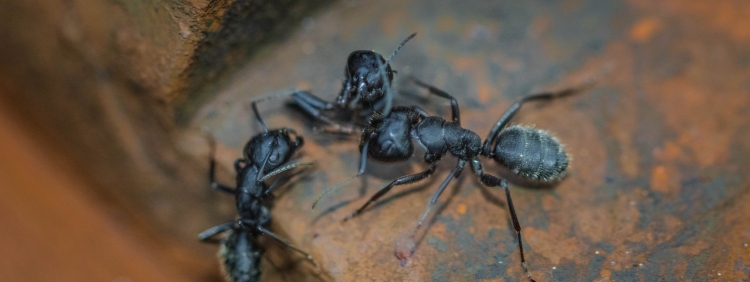The Secret Life of Carpenter Ants in Cambridge: A Guide to Prevention and Control

If there’s one thing we know you’d rather not find out after moving to a charming little town like Cambridge, it’s that you’re sharing your home with an infestation of carpenter ants. These pesky invaders nest inside your home’s wooden structures, causing damage that can even reach a critical level if not promptly addressed by a carpenter ant control in Cambridge specialist.
Before you start packing up to move again, take a deep breath. There’s good news – you can prevent and control these industrious insects with the right knowledge and tools. And that’s just what we’re here to provide.
Remember, knowledge is the most powerful tool in any war, including your battle against carpenter ants. The more you know about their habits and behaviours, the more efficiently you can keep your household pest free.
Identifying Carpenter Ants
To begin, understanding what carpenter ants look like and how they behave can be invaluable for early detection and prevention. They are large ants, usually between 1/4 and 1/2 inch in length, and can be black, brown, reddish, or even a combination of colours. Unlike termites, they don’t eat wood; instead, they excavate it to establish their nests, which is why they can damage the structural integrity of your home.
- Physical Attributes: They have a pinched waist, elbowed antennae, and if wings are present, the hind wings are smaller than the front wings.
- Behaviour: They are usually more active during the night, and are often seen carrying debris from their nest, including sawdust-like material and dead ant parts.
Signs Of Carpenter Ant Activity In Your Home
Recognizing the signs of activity is essential to prevent them from causing significant damage to your home. These signs vary and might not be evident until the infestation is reasonably advanced. Here are some things to be on the look-out for:
Sawdust and Wood Shavings
You’ll often find carpenter ants have left behind a trail of sawdust or wood shavings. They don’t eat the wood but carve it out to make their nests. This sawdust, also known as ‘frass,’ is often mistaken as a mere household mess but could signify much more about the secret lives of these tiny invaders. If you notice small piles of this frass near wooden structures like baseboards, doors, windowsills, and furniture, it’s best to investigate further.
Noises in the Walls or Ceilings
A lesser-known sign of carpenter ant activity is the rustling sound they make. When a colony of these ants is large enough, you might hear faint rustling noises in the walls or ceilings — especially at night. Think of it as the sound of thousands of tiny carpenters, hard at work in their secret world. Consequently, if you consistently hear unexplained sounds, it could be a silent alarm for a hidden infestation.
A Parade of Ants
It’s common to spot a few ants in the household at times. However, a steady flow of ants marching across your countertop, floor, or anywhere else in your home could indicate a sizable colony living secretly within your abode’s very fabric. These ants follow pheromone trails to food sources, so such a ‘parade’ might well lead back to their hidden nest.
Wing Shedding
Carpenter ants, like other ant species, have a caste system within their colonies, with certain individuals – the ‘reproductives’ – having wings. During certain seasons when these reproductives leave for their nuptial flight, they shed their wings, a phenomenon that often results in finding discarded wings around the house. So, those wings on your windowsills or floors might indeed reveal a secret life currently unfolding within your property.
Preventing Carpenter Ant Infestations
Carpenter ants prefer moist and decaying wood, so ensure you keep your home dry and repair any rotting woodwork promptly. Also, remember these ants are skillful climbers. They can sneak into your property via tree branches touching your house. Hence, trimming all branches that create a bridge to your home is crucial.
Further, firewood or timber stored near your home functions as a luxury hotel. It is advisable to store them at least a few meters away from your house or any other wooden structures. However, keeping a distance doesn’t guarantee total safety. Regularly inspect your firewood or timber for any signs of these damaging ants to ensure they haven’t set up their quarters.
Cleanliness is Key
Like many pests, carpenter ants are attracted by food. Particularly, their sweet tooth can lead them straight into your kitchen. Always clear up food scraps, spills, and crumbs immediately. It’s not just about cleaning visible areas; you should also be thorough behind appliances and inside cupboards. Furthermore, tightly seal your food containers and regularly take out the trash.
Sealing the Entrances

Carpenter ants exhibit exceptional cunning when it comes to finding entryways into your home. From minute cracks in the foundation to gaps in windows and doors, these ants leave no stone unturned. Therefore, ensure all possible entries are sealed. Use caulk to seal cracks, ensure your doors and windows are fitted correctly and use weather stripping where necessary.
Remember, ant control isn’t a one-time affair. Consistent preventive measures are key to ensuring your home stays pest free. The saying, “prevention is better than cure,” could not be more accurate when it comes to dealing with these wood-loving pests. So, stay alert, keep clean, and always be on the lookout for any signs of an infestation.
Keeping Your Garden Carpenter Ant-Free
Your garden can equally be a battleground when it comes to carpenter ants. A few simple steps can help protect your outdoor paradise from these unwelcome invaders.
Timely Pruning
Carpenter ants can use tree branches and shrubs as bridges to access your home. It’s therefore essential to prune your shrubs and cut back tree branches that come in contact with your house. Good spacing between plants can also discourage the movement of ants.
Outdoor Sanitation
In the garden, good sanitation practices go a long way. Limit water sources available to the ants by fixing any leaky outdoor faucets and ensuring proper drainage around your home. Clear out dead or rotting trees and stumps that may serve as a home for colonies. Regularly pick up fallen fruits or vegetables from your garden to avoid attracting these ants with a free feast!
Remember, the goal is to create an environment that’s least appealing to carpenter ants. These steps may seem basic, but it’s often simple precautions that prove the most effective. Use these strategies consistently to protect your home and garden from the destructive effects of a carpenter ant invasion.
Seek Expert Help: Hiring Professional Pest Control
When a particularly extensive infestation occurs, call a professional pest control service like Truly Nolen. We are equipped with the right tools, skills, and knowledge to handle all sorts of pests, including the pesky carpenter ants. With our experience in the field, we can effectively locate nests, identify species, and devise tailor-made solutions that ensure the complete eradication of the colony.
While preventive measures are a good start, sometimes you need the cavalry to truly bring an end to a carpenter ant invasion.
When it comes to carpenter ants, it is important to remember that they don’t just live in one colony within your home. In fact, it is possible for multiple colonies to be scattered throughout your property, some even outside. To effectively and completely eliminate all nests, a thorough extermination process is necessary. That’s where Truly Nolen comes in with our Four Seasons approach. Our team will not only eradicate all colonies but also take preventative measures to make sure they don’t return.
Maintain the health and structural integrity of your home and contact us for carpenter ant control in Cambridge today!